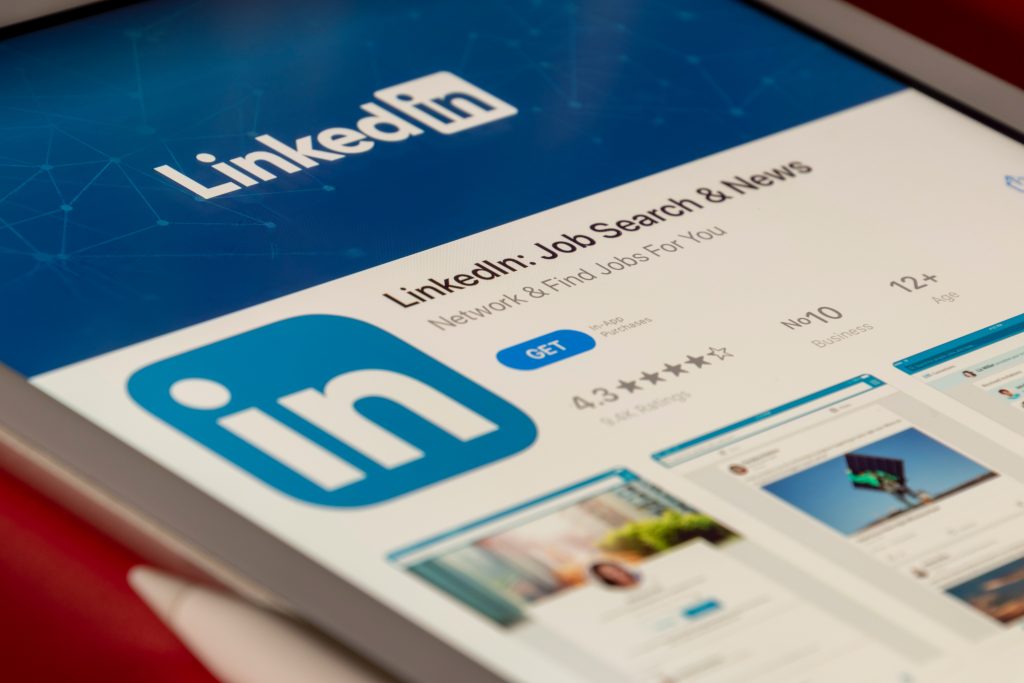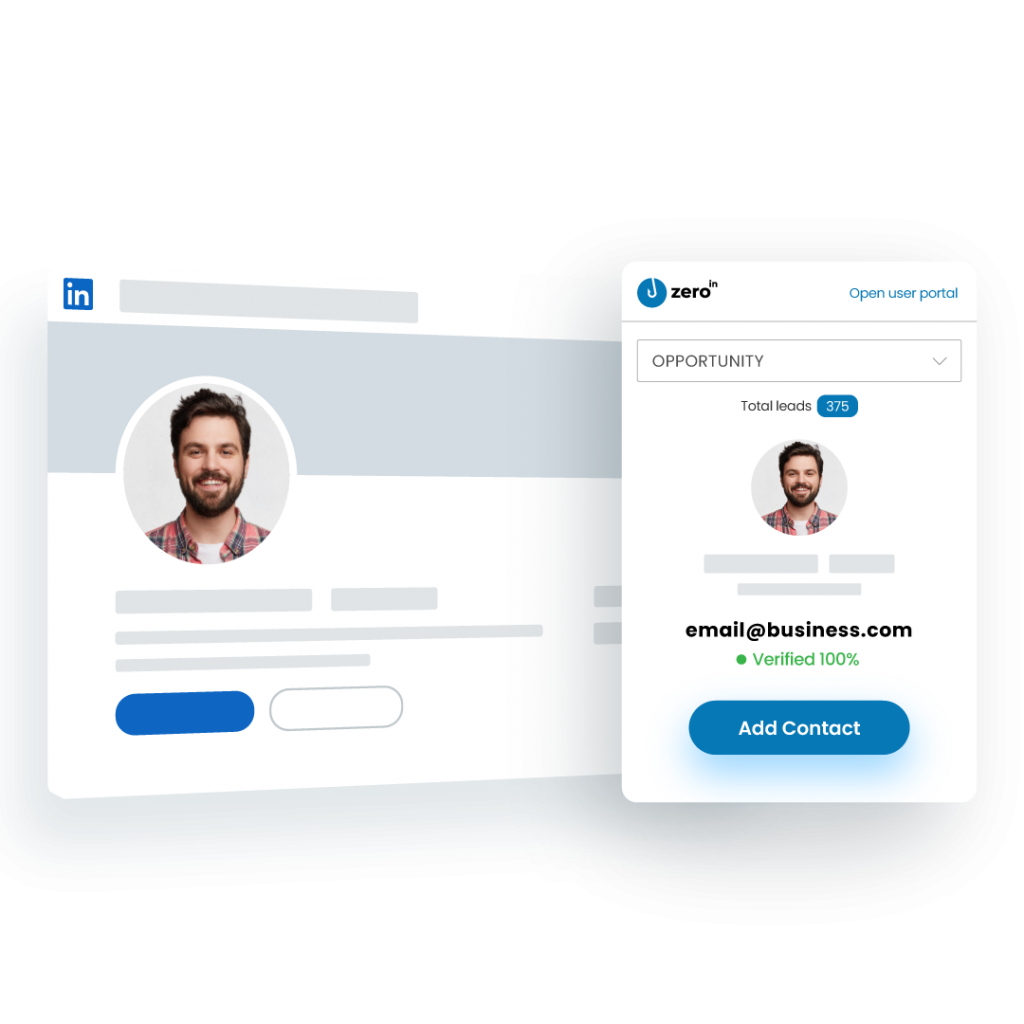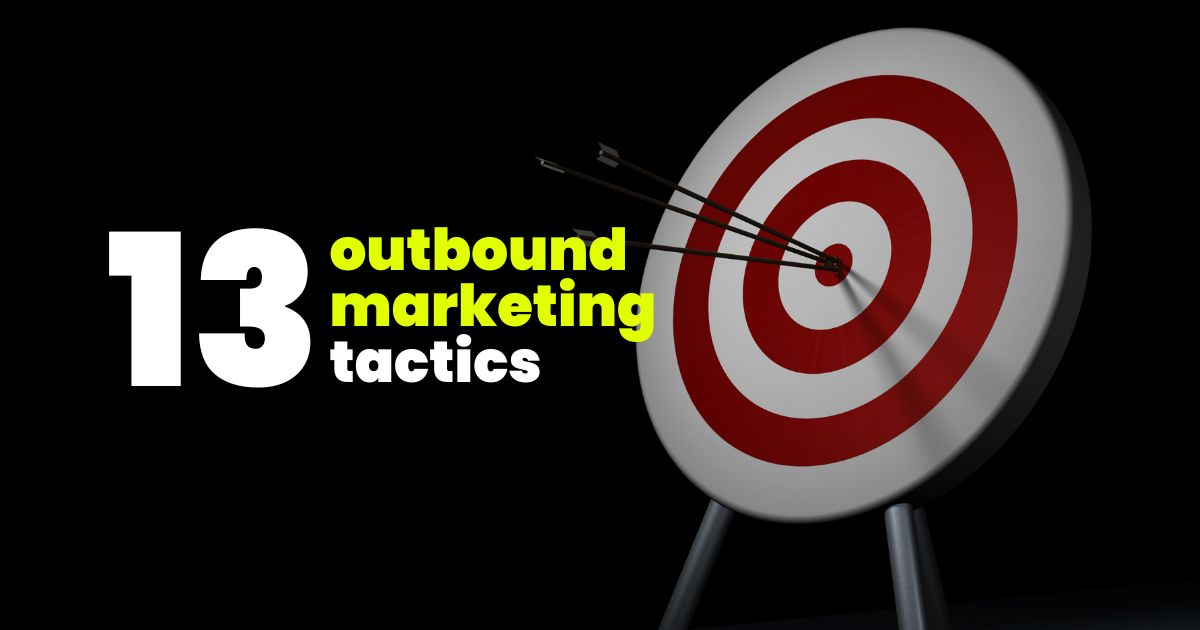Summary
By the end of this article, you’ll become a master of B2B outbound marketing tactics. We’ll start from the basics, go over expert strategies, and give you examples and some extra tips to boost your business growth.
What is a B2B Outbound Marketing Tactic?
A B2B outbound marketing tactic entails actively reaching out to prospective customers (also businesses) through various channels such as cold emails, cold calls, and social media advertising.
Salespeople would target other businesses likely to become their customers and proactively reach out to them to pitch their product or service. As such, it’s a direct and laser-focused approach that enables even new businesses to quickly close sales.
What is the Difference Between B2B Outbound and Inbound Marketing Tactics?
Outbound marketing involves proactive and direct outreach to prospective customers.
Inbound marketing is all about attracting customers organically by providing valuable content so that your customers come to you, usually through search engines or social media.
At this point, you’d typically ask: which one is better? But the truth is that you need both.
Definitely invest in inbound marketing in the long term, but don’t forget that outbound is the one that will generate leads quickly and drive sales.
That being said, it’s important to note that inbound marketing takes time. You need to create valuable content to build trust and authority, work on your SEO to improve your online visibility and nurture relationships with your audience. It might take months before you start seeing the first leads coming in.
The key is to find the right balance between immediate results and sustainable growth. Today, we’ll be focusing on tactics that can help you achieve those immediate results.
How to Choose Successful Marketing Tactics in Your Outbound B2B Efforts?
There are a bunch of outbound marketing tactics that you can adopt. However, the right ones for your will depend on your specific case, starting with realistic possibilities such as available human resources, knowledge, budget, and more.
In this section, we will guide you through the process of selecting the most successful marketing tactics by considering these crucial elements.
1. Analyze Your Target Audience
Before you start doing anything else, it’s crucial that you understand your target audience and come up with your ideal customer profile (ICP).
Engage in detailed research to identify your audience’s pain points, needs, demographics, preferences, budgets, and anything else you can find, really. All this information is necessary for your ICP. And why is an ICP important?
Because it ultimately helps you sell more and see a higher return on your investment. You find better leads, you better personalize your communications, and ta-da: in comes the revenue.
To start with your ICP, we recommend looking into your current best customers and identifying the features they have in the comments. But don’t feel pressured to get every single thing right.
After all, you’re meant to adjust your ideal customer profile as your business grows.
Finally, if you’re only starting and haven’t yet found customers — make a hypothesis. Then give it a try, and the same as above, adjust it along the way.
2. Assess Your Competitive Landscape
To create the best offer and marketing outbound strategy, you have to know who you’re competing with. The next step is researching the market and your competitors.
Identify your competitors and check out their offerings. Where do you fit in the market? What makes your business stand out? Try to come up with an answer and tweak it as you go.
More importantly for the topic at hand, evaluate their marketing strategies. What are they doing? Is it working in your industry or not? Why?
This is where you can identify opportunities to differentiate yourself, as well as flat-out avoid the tactics that have been proven not to work.
By understanding your competitive landscape, you can select tactics that give you a competitive edge and maximize your chances of success.
3. Set Clear and Measurable Goals
How do you know if your outbound marketing tactics are working? You set clear and measurable goals, of course!
Generating a specific number of leads, increasing your conversion rates, boosting brand awareness, some other goals, or all together! As long as you clearly define some numbers.
It’s best if you have a goal that you track for each step in your sales funnel, but don’t get lost in all the numbers: sales should always be your end goal.
Analyze each step, adjust your B2B outbound marketing tactics depending on the results, and start over.
As for the numbers, if you’re asking us, always best to set one that seems just that one bit out of your reach. But do it: having well-defined goals will help you choose tactics that align with your objectives and track your progress effectively.
4. Leverage Data and Analytics
Once you’ve set your goals, it’s time to track data and analyze so that you can make informed decisions about your marketing tactics.
This goes for the things you already did in the past, too, as it will help you come up with the best strategy once you’re done reading this article. Go back, and analyze your past performance, and key metrics, and try to identify patterns and trends.
When you then look at this data, you’ll be able to optimize your outbound marketing, allocate your budget and make data-driven decisions in the future.
5. Consider the Buyer’s Journey
You have your funnel, right? But have you identified each stage and made sure you provide relevant content to the leads in each of the stages? It’s what makes or breaks your outbound marketing strategy.
It’s important that you choose tactics that align with where the buyer is in their journey, from awareness to consideration and decision-making.
Outbound is all about serving the right message at the right moment to the right people. And boom, your conversion rate explodes.
6. Find the right channels
This may sound creepy — but it’s time to find out where your potential customers dwell.
You should identify the channels where your target audience is the most active and receptive to marketing messages.
Suffice it to say, in B2B outbound marketing, this will almost always be LinkedIn. And in cases like those, we strongly recommend you make room in your budget for Sales Navigator.

However, depending on your industry, these channels may also include some industry-specific forums or events, or simply emails.
7. Align Tactics with Resources and Expertise
There are many, many great B2B outbound marketing tactics out there, but not each one is made for you, or at least not in the stage you’re in currently.
It will make your life easier to evaluate your available resources and expertise when selecting the tactics to adopt right away.
How big is your marketing team? What’s your budget? What’s your team’s expertise?
Answer all these questions and only then wisely choose tactics that align with your resources to ensure effective execution and maximize your ROI.
8. Test and Iterate
Ah… the Holy Grail of effective marketing! Also known as A/B testing.
Don’t be afraid to experiment and test different outbound tactics to find what works best for your business.
Choose one aspect to test, track results, and when you have a statistically significant result, tweak, tweak, tweak.
Continuous testing and optimization will help you refine your marketing strategy and uncover the most successful tactics for your specific business.
9. Consider Industry Trends
Look… This industry is moving fast. By the time you’ve finished reading this article, it’s likely that new trends and marketing tactics will already pop up.
Stay open-minded, follow marketing industry blogs (such as this one 😎), and incorporate new ideas and technologies that could secure you a competitive advantage.
Keeping up with industry trends ensures that your marketing tactics stay relevant and effective in a dynamic business landscape.
10. Align Marketing and Sales
If your marketing and sales departments aren’t aligned yet, you’re seriously missing out.
These two teams are interdependent and have super valuable insights that, when shared, could transform your business.
The sales team should be actively involved in creating the outbound marketing strategy, simply because they have valuable, tested-and-tried insight into customer interactions, pain points, objections, and feedback.
Because it comes directly from the customers, it means that the marketing material you create will be highly relevant and provide a greater return on investment.
Additionally, this will also help the sales team close sales since your outbound marketing tactics will also align with their needs and effectively support their sales efforts.
11. Consider the Multichannel Approach
Make sure that you consider the multichannel approach.
Not only could your target audience be divided among different channels, but they likely have preferences of where they’d like to be contacted.
Write up the list of the different channels you could use with the resources you have available, and start outlining your strategy and pushing your content.
You’ll end up significantly increasing your reach, and when you contact your leads on their preferred platforms, you’re also increasing your chances of converting them into customers.
12. Seek Customer Feedback
If you’re struggling to come up with the right marketing messages to use in your outbound marketing, look no further than your existing customers.
Don’t be afraid to ask them questions and send them surveys. This will help you gain insights into what attracted them to your business, and more importantly, why they’ve chosen it instead of your competitors.
Then use that feedback to inform your outbound marketing tactics and successfully identify your unique selling points and value propositions that resonate with your ideal customer profile.
13. Stay Agile and Adapt
Last, but not least, stay agile and stay prepared to tweak your outbound marketing tactics along the way. It’s the key to ensuring your efforts remain effective in a rapidly evolving landscape.
Your customers’ preferences may change, they may experience fatigue, the technology may change, or even the market itself. And that’s when flexibility helps keep your business on top.
Choosing the Right Mix of Tactics
So, how do you know if you’ve chosen the right mix of outbound marketing tactics?
No way to know until you’ve tried! But a good guideline is to choose the tactics that align with your business goals, the ones that will ensure you meet your targets.
Regularly monitor and evaluate the performance of each tactic, making adjustments as needed to optimize your results, and you’ll be well on your way.
Expert Tips Before You Start
Before you start, there are four things you should do to ensure your outbound marketing tactics don’t go to waste. Without further ado…
1. Write your Ideal Customer Profile (ICP)
We’ve mentioned it before, but it is almost pointless to start working on anything before you have written your ideal customer profile.

When you write a precise ICP, you can hone in your efforts on the potential customers that are truly likely to convert — as opposed to spending time on leads who may not actually need your products or services at all.
This will also allow for a higher level of personalization in your communications, helping you close sales more easily at a lower cost.
2. Create a List of High-Quality Leads
With an ICP, it will be that much easier to create a list of high-quality leads.
Simply input the ICP specifics into the LinkedIn search filters (or any other database you may be using) and ta-daa: you get a list of search results of valuable potential customers.
And then, it’s time to ensure the contact information you find is high quality so as not to risk your email deliverability rates. Put your Googling skills to the test and think about using a convenient email-finding tool such as ZeroIn.
You can install it as a browser extension, after which it can match individual LinkedIn profiles (or the full search results page in bulk) to the business email address (and more) from its extensive 200M database.

All the emails are verified with a high level of accuracy so you can ensure the contact information you find is of the highest quality.
3. Use a Light CRM at the Beginning
Are you using a CRM? If not, you should definitely consider getting at least a light variant for the beginning. It’s what will ensure you don’t forget valuable prospect information, a follow up date, and more.
A CRM tool provides a seamless way to manage your leads, keep track of their progress, document your communications and interactions, and even set up reminders for follow-ups. This ensures that no high-quality leads slip through the cracks.
In case you opt for the ZeroIn email finder mentioned earlier, you’ll be pleased to discover that it includes a user-friendly CRM tool. This lightweight CRM tool is ideal for those starting out with a B2B outbound marketing tactic.

4. Create an Irresistible Offer
Your offer has to at least match, but preferably stand out from the rest of the market.
It’s why it is important that you research your competitors and then come up with the best possible value proposition, without incurring losses.
Package your offer in an appealing way that resonates with your customers. It should stimulate action and engage your prospects.
To start with, think about things that usually make you convert. You could start with time-limited offers, demos, free trials, etc.
Conclusion
Congrats! You’ve arrived at the end of this list of B2B outbound marketing tactics, and we sincerely hope it helps.
Our advice is to go through it and start applying as many of these steps as possible so that you can craft the best B2B outbound marketing strategy and actively start going out there.
Good luck!
What is ZeroIn?
Introducing ZeroIn: an all-in-one email discovery solution, complete with a streamlined CRM for effortless organization and management of valuable prospect data. Beyond essential contact details like business emails and phone numbers, ZeroIn uncovers over 20 additional insights related to your contacts and their companies.
Effortlessly integrated with your Free or Sales Navigator LinkedIn searches, ZeroIn empowers your outreach through a browser extension that applies your search criteria and harnesses its vast database to present a complete picture of your potential clients.
ZeroIn goes beyond the ordinary by delivering up to 26 unique data points, including verified business emails, outshining conventional data such as phone numbers and email addresses. Our exclusive 10-step verification process guarantees the accuracy and legitimacy of every email address you encounter.
Moreover, ZeroIn enables you to import and re-verify existing email lists, and conveniently export leads in versatile formats like CSV, XLS, and Google Drive.
For those times when you need a quick assessment, ZeroIn’s “single email verification” feature offers rapid, reliable checks on individual email addresses. Elevate your prospecting game with ZeroIn – the ultimate tool for email discovery and management.
How can ZeroIn help your business?
ZeroIn helps you boost your outreach and sales by streamlining prospect list building. You can find and verify prospect email addresses in a click, both individually and in bulk while keeping your CRM data clean through the duplicate finder.
Because it offers a lifetime, pay once, and use forever deal, ZeroIn is ideal for SMBs in the growth stage.
Create a Free Account and Get 25 credits!
FAQ
What is a B2B Outbound Marketing Tactic?
A B2B outbound marketing tactic involves actively reaching out to your prospective customers through a variety of different channels such as emails, calls, social media advertising, and more. It’s B2B because you’re a business selling to other businesses.
It starts with targeting relevant people in other businesses whom you then pitch to. It’s a direct and laser-focused approach that enables even new businesses to quickly close sales.
What is the Difference Between B2B Outbound and Inbound Marketing Tactics?
Outbound marketing is proactive and direct outreach to potential customers.
On the other hand, with inbound marketing, the customers come to you. This typically includes attracting them organically through valuable content, usually through search engines or social media.
Neither is better or worse than the other one: every company needs both. That being said, they can serve different purposes.
Inbound marketing is great in the long term because it takes a longer time to develop. You have to create lots of valuable content, and wait until it gets picked up by the search engines and noticed by your audience. It may take months before the first results start coming in.
But when it gets to this point, it does wonders.
Outbound marketing is the one that will generate leads and drive sales quickly, though. Because you’re actively reaching out to each potential customers, you significantly shorten this cycle.
The key is to find the right balance between these immediate results and sustainable growth that inbound brings to the table.
How to Choose Successful Marketing Tactics in Your Outbound B2B Efforts?
The outbound marketing tactics you choose will depend on a variety of factors, starting with answer the question: what are the realistic possibilities for my company?
What’s your budget? What human resources do you have? Where does your expertise lie?
Answer these questions, and you’ll have a good idea of which tactics are realistic for you at the moment. At a later stage, you can always adopt additional ones.
And how will you know which tactics are right for you? This answer may disappoint you, but you won’t know until you’ve tried.
A good guideline is to choose the tactics that align with your business goals, the ones that will ensure you meet your targets.
Regularly monitor and evaluate the performance of each tactic, making adjustments as needed to optimize your results, and you’ll be well on your way.
